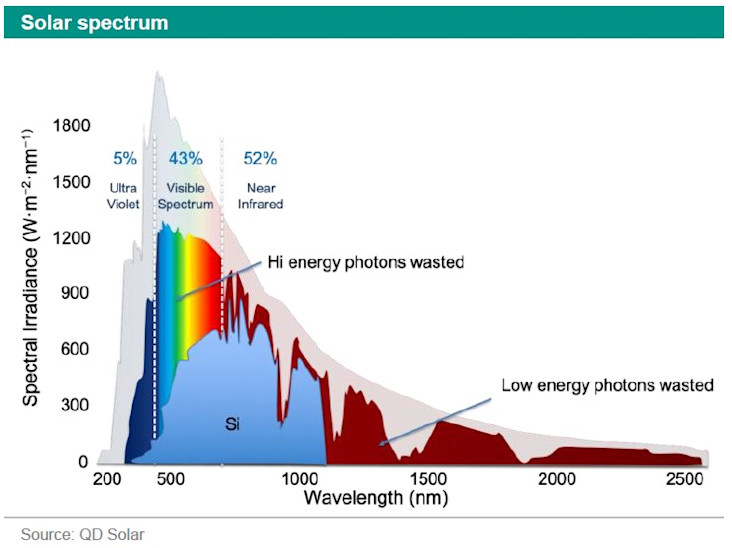Emerging solar technologies could be game changers

Solar power is a key renewable source for the energy transition. But it has three major challenges: efficiency, intermittency and materials use. The emerging solar technologies aim to tackle these challenges but they are not commercially ready. The emerging technologies that could be game changers are: perovskites, quantum dots, thermochromic photovoltaic glass and night solar. We take a closer look into these.
Solar power is a key renewable source for the energy transition
But it has three major challenges: efficiency, intermittency and materials use
The emerging solar technologies aim to tackle these challenges but they are not commercially ready
The emerging technologies that could be game changers are: perovskites, quantum dots, thermochromic photovoltaic glass and night solar
Introduction:
Solar power is a key renewable source for the energy transition. Globally, solar power has been the fastest growing clean technology. In 2022 solar capacity stood at 224 GW or 13% of the total renewable capacity globally. There are currently three major challenges to solve: efficiency, intermittency and materials use. Rooftop solar panels have on average 19-21% efficiency. Scientists are working on improving solar efficiency, reducing the costs and developing new technologies. In an ideal world, solar cells are integrated in buildings and the windows darken on sunny days and also generate electricity. Moreover, solar panels would work when the sun sets so there is no longer the challenge of intermittency. In this report we focus on the current and emerging technologies and how far are we from an ideal world. We first start with some basics about solar technology. We continue afterwards with the different solar technologies, other emerging technologies and applications.
How does photovoltaics work?
Solar energy reaches Earth as electromagnetic radiation that travels through space at the speed of light. It takes about 8.33 minutes to move from the Sun to the Earth. Some of this radiation is reflected off the clouds or absorbed by the atmosphere, while some passes through to the Earth’s surface. The amount of energy depends on the angle of the sun’s ray and the local weather. As light falls on the source of a solar cell, the energy moves electrons. Connected to a circuit, the solar cell becomes a source of electric current. This is called the photoelectric effect. So solar cells are devices that convert incident light energy to electric energy. Most solar panels are built with materials (mainly silicon) that physically interact with certain wavelengths of solar energy. The graph below shows the part of solar radiation that silicon (Si) captures.

Almost 50% of solar spectrum is not captured by the majority of solar panels. This is because of the materials used (mainly silicon). Long wave infrared light lacks the energy to move the electrons, while the shortwave ultraviolet light has too much energy. If different materials are used then another part of the light could be captured. However there are two other challenges. First around 25% of the light energy is lost because of how electrons behave. Second about 14% is lost via resistance to current flow (). So of the total light energy 50% is used and of that 39% is lost (25%+14%) meaning the theoretical maximum efficiency of the solar panels that use silicon (majority) is about 32%. Most home solar panels have efficiency ratings between 19% and 21%. This may be low, but this is relatively high compared to the theoretical maximum efficiency of 32%.
What solar technologies are there?
There are four generations of solar cells. Moreover, there are also two other technologies that we focus on: thermochromic photovoltaic glass and night solar. These technologies are explained below.
First generation
First generation are crystalline silicon solar cells. This can be monocrystalline or polycrystalline solar cells. Monocrystalline silicon is a single crystal silicon meaning it is a homogeneous material. It has a higher efficiency compared to polycrystalline but the production is less efficient and creates material waste. Polycrystalline silicon is compiled of several small crystallites. It is non-homogeneous. Monocrystalline silicon has an efficiency in production of around 20-22% and polycrystalline 18-20%. The majority of the solar cells on the market are first generation crystalline silicon solar cells.
Second generation
The second generation solar cells are newer photovoltaic technology and consist of one or more thin films of photovoltaic materials on a substrate. These cells are thinner, flexible, cheaper, and have a wider use. The thickness of the film is in nanometres. These films can be used in Building Integrated PV (BIPV) such as solar tiles, solar windows, solar walls, roof-integrates panels, solar panel blinds and PV solar noise barriers. These thin-film cells absorb a different part of solar radiation than crystalline silicon because the materials used interact differently with light. Their major disadvantage is that on a commercial scale they are inefficient. Another drawback is that some of the materials are toxic (Cadmium) and other are scarce (Tellurium). On a commercial scale they have an efficiency of around 12-16% ().
Third generation
Third generation solar cells are emerging technologies. They are much cheaper and easy to produce on the roll-to-roll method. However, none of them has shown commercial efficiency similar to crystalline silicon cells. Examples are: dye-sensitized solar cells, organic solar cells, copper sinc tin sulfide (CZTS) solar cells, perovskite solar cells, quantum dot solar cells. The latter two get the most attention and we explain them below.
A perovskite is any compound whose crystal structure resembles that of calcium titanium oxide. They are thin film devices built with layers of materials. The costs of raw materials are lower compared to other solar technologies. Perovskites can be tuned to respond to different colours in the solar spectrum by changing the material composition. So they can be combined with another differently tuned absorber material to deliver more power from the same device. This is called tandem device architecture (). By doing this the efficiency percentage will increase considerably. But the major challenge is the stability of the material. They can degrade quickly when exposed to heat, moisture and snow.
Another promising emerging solar technology is quantum dots. They are considered to be artificial atoms. Their energy levels are adjustable by altering their size. So the size of the quantum dot defines what part of the spectrum of sunlight can be absorbed. Some of the materials are toxic though. Moreover, degradation increases in aqueous and UV conditions.
Fourth generation
Fourth generation solar cells aim to capture a wider spectrum by using different materials with different absorption such as perovskite and quantum dots. Then 50% of the spectrum light is no longer lost. As a result the theoretical maximum efficiency will increase. These are called multi junction solar cells.
Other technologies
In this section we focus on two other technologies: thermochromic photovoltaic glass and night solar. Thermochromic glass is a window that darkens when the heat from direct sun is on the window. A photovoltaic window is a window that have solar cells embedded that generate electricity. Thermochromic photovoltaic technology allows the window to change colour to block glare and reduce unwanted solar heating when the glass gets warm on a hot and sunny day. This colour change also leads to the formation of a functioning solar cell that generates power. The perovskites embedded within the material generate the electricity (). This is also called Switch Glaze. So it is combination of thermochromatic and photovoltaics. It is not commercially available yet as researchers are working on improving the technology.
In most emerging technologies, scientists aim to increase efficiency by using materials or a combination of different materials that absorb a larger proportion of the solar spectrum. These solar cells only work when the sun is up. Are there also panels that work when it is dark? Indeed there are! These solar cells are called night solar. Last year, there was a major breakthrough. Night-time solar can deliver power in the dark. They work like solar panels in reverse. They consist of a thermoradiative diode also found in night-vision googles. This diode works like the inverse of a solar cell accepting thermal energy radiated upward from the Earth into a colder area and turning the flow of energy across the energy differential into electrical potential. So night solar can tap the heat or infrared light falling on the panel’s surface to generate electricity. But currently night solar is only able to produce a fraction of what solar panels produce (around 0.04%). If the efficiency of this technology would increase substantially, battery storage in most cases would no longer be necessary.
Conclusion
To reach net-zero by 2050 photovoltaics energy plays a crucial role. But there are three challenges to photovoltaics energy. First, current solar panels only absorb part of the solar spectrum and therefore the maximum theoretical efficiency is 32%. Second, solar panels don’t work when the sun is set. Third, several types and a lot of materials are used for the production of solar cells. The next generation solar technologies (especially third generation and higher) aim to overcome these challenges. Some of the technologies could have a major impact if they become commercially available such as perovskite, quantum dots, thermochromic photovoltaic glass and night solar. But none of these emerging technologies have shown commercial efficiency similar to crystalline silicon cells, some of them are not stable and others use toxic and or rare materials.
This article is part of the SustainaWeekly of 28 August 2023
